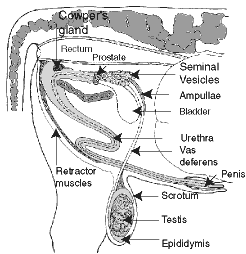The reproductive tract of the bull consists of the testicles, secondary sex organs, and three accessory sex glands. These organs work in concert for the formation, maturation and transport of spermatozoa, which are eventually deposited in the female reproductive tract. The secondary sex organs are the epididymis, vas deferens and penis. The three accessory sex glands include the seminal vesicles, prostate and bulbourethral gland (Cowper's gland). This basic anatomy is illustrated in the figure.

The testes of the bull produce the male sexual cells or spermatozoa which, like the egg, contain only one copy of the genetic information necessary to constitute an individual. Although the male sexual organs) begin to produce hormones before birth, the production of spermatozoa begins only at puberty (seven to 12 months of age).
Scrotum
The scrotum is the sack located outside the abdominal cavity that contains the testes. By adjusting the distance between the testes and the body, the scrotum regulates the temperature of the testes. This is necessary because the formation of spermatozoa functions better at a temperature 2 to 4°C lower than normal body temperature.
Some bulls have only one testis in the scrotum. This descended testis will function properly, but the one that remains in the body cavity will not. This condition is inherited, and these bulls should not be used so the propagation of this defect will be avoided.
Testes

Each testis is enveloped in its own compartment and each is a complete, independent unit. The testes are primarily made of small tubules (seminiferous tubules) where the production of spermatozoa takes place. Some specialised cells (called Leydig cells or interstitial cells) are dispersed throughout the tissues of the testes and produce testosterone, the predominant male hormone.

At the time of mating, before the sperm is ejaculated, the spermatozoa are mixed with secretions rich in nutritive substances from the secondary sex organs.
Formation of the Spermatozoa
It takes about 64 to 74 days for the formation of spermatozoa and 14 to 18 days for sperm to travel through the epididymis (site of accumulation and final maturation of spermatozoa). Thus, symptoms of bull infertility may occur two and a half to three months after the process of sperm formation has been impaired. In general, sperm formation increases with the weight and diameter of the testes. Thus, larger and older bulls (that are likely to have larger testes) usually produce more sperm than smaller or younger bulls. The secretion of the accessory glands contributes, on average, up to 80% of the total volume of the ejaculated semen. A young bull coming into service produces as little as one or two ml of semen per ejaculation whereas a fully mature bull may produce 10 to 15 ml of semen per ejaculation. In general, when a bull serves a second or even a third time in succession, the volume of ejaculate does not decrease, but the concentration of spermatozoa tends to decrease. Frequent ejaculations do not usually affect an adult bull's fertility, but a young bull should be used more carefully.
Signs of Libido in Bulls
As the cow reaches oestrus the bull becomes very excited and follows her closely, licking and smelling her external genitalia and often exhibiting flehmen. Recent work has shown that the bull uses the tongue to transfer fluid (probably urine) to a short incisive spur located on the dental pad. It is then transferred to the vomeronasal organ which is considered to be the site of pheromone identification. Pre-copulatory patterns include pawing the ground and snorting, chin resting on the cow’s rump just before mounting and then copulation. Copulation is short (seconds) compared with horses and pigs (minutes).
The social ranking of bulls can influence their sexual activity, the most dominant animals mate the most.
The level of sexual behaviour displayed is determined by genetics, environmental factors, physiological factors, health and previous experience, e.g., bulls of dairy breeds are generally more sexually active than those of the beef breeds. New herd members attract greater sexual attention. Therefore, their introduction to a breeding group can be a useful means of stimulating sluggish bulls.
Testosterone and oestrogen enhance the libido of males and females respectively. Oestrus duration of cows is longer when there are many other cows in oestrus at the same time.
The bull detects the pro-oestrus cow about 2 days before oestrus and remains in her general vicinity.
During the oestrus period, the cow increases her frequency of urination, so the bull can sample both the odours and the taste of her urine.
The period of sexual receptivity (mounting behaviour) ranges from 1 to 18 hours, with the average being about 4.4 hours.
Bulls that are used for AI or hand-breeding may have poor semen quality or poor reproductive behaviour, due to the lack of stimulatory effects that result from the prolonged courtship.
Bulls commonly masturbate, especially at times of inactivity.
Mounting causes an immobilisation reflex (rigid stance) in the oestrus females that are being mounted.
Click here to view a video that explains the bull's reproductive anatomy.